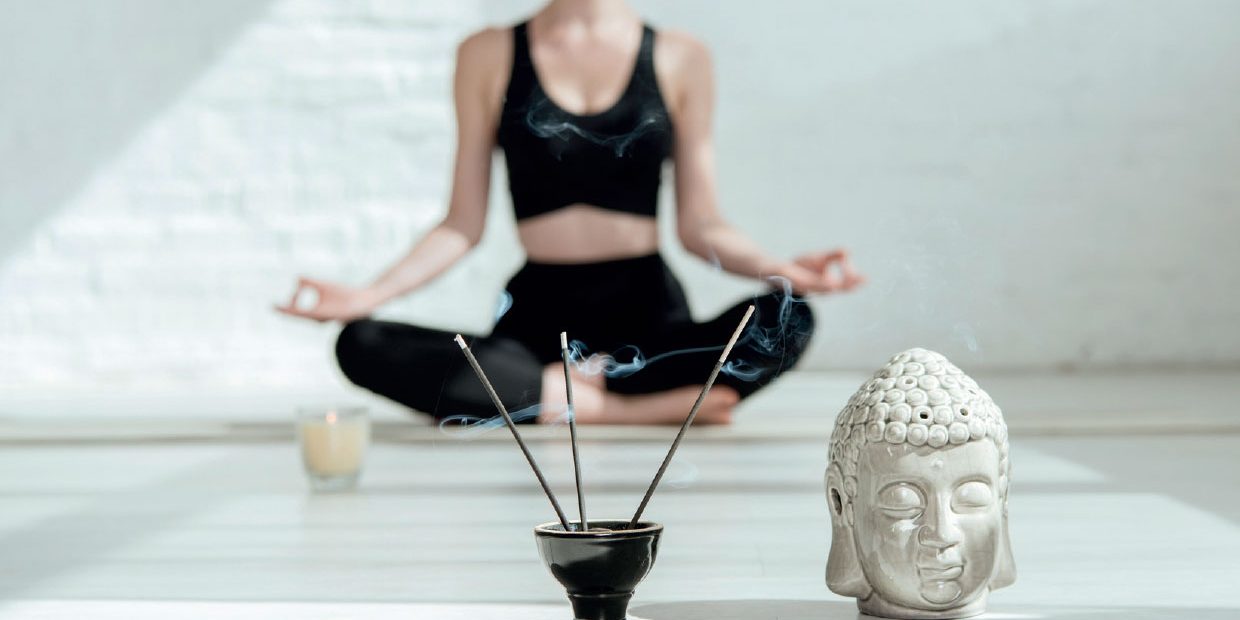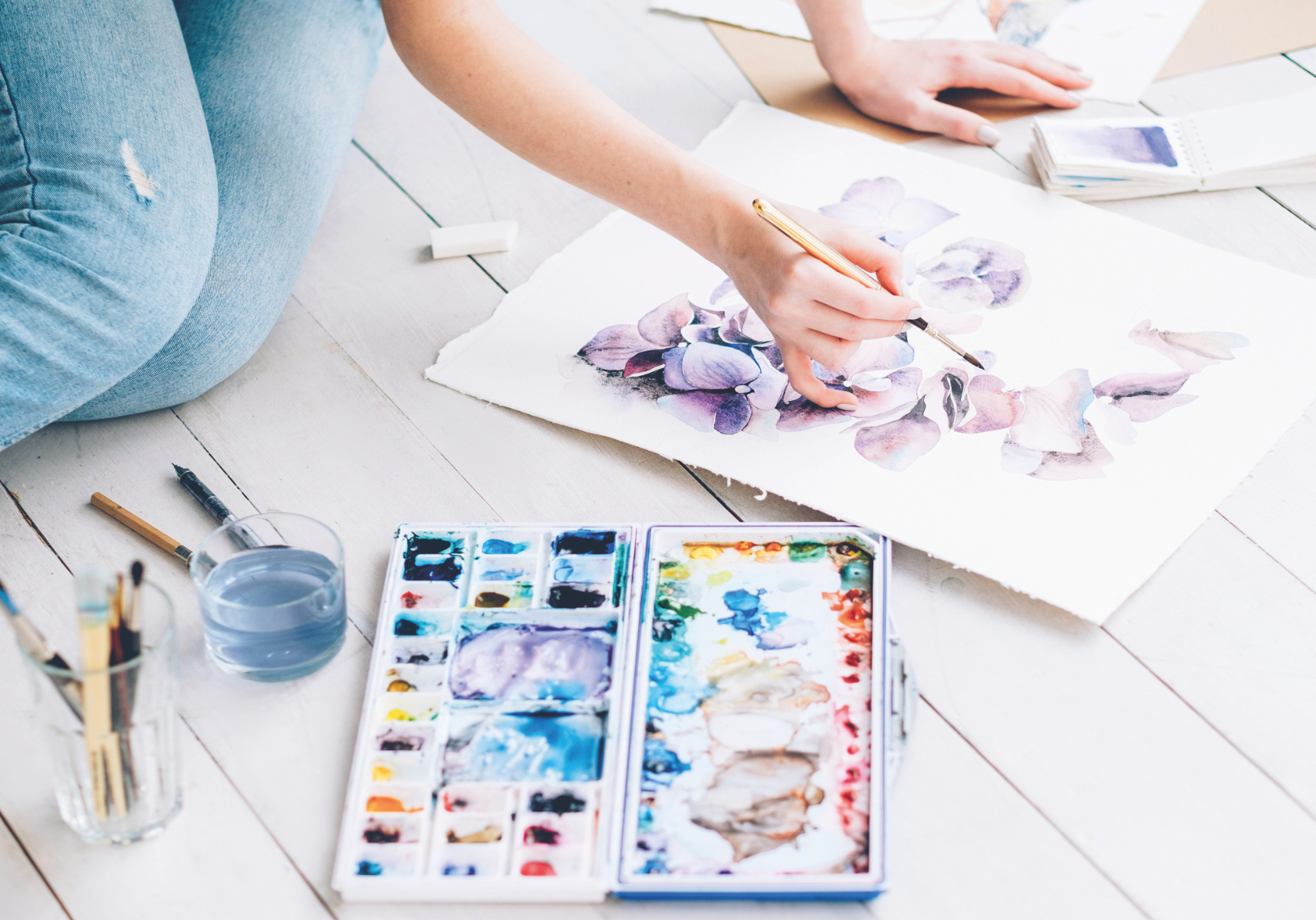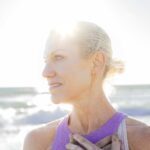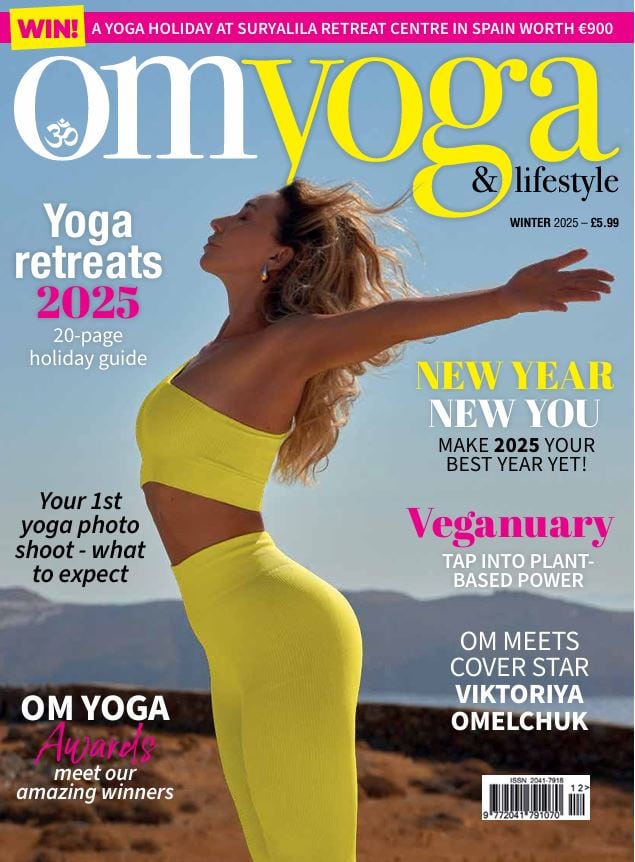
The thread that binds us
Yoga, art, music and life itself — it all comes from the same place. Our creative life force expression is unlimited, enduring, and one that we must continually strive to explore whether on the yoga mat or crafting a number one hit. By Andrea Marcum
Reading time: 6-7 minutes
Back before I discovered yoga, when I was a singer songwriter, I somehow managed to get invited to Joni Mitchell’s 50th birthday party. It was in Venice Beach, California at just the sort of swanky artist’s loft you would expect it to be — down an unassuming little side street and hidden behind an enormous concrete wall.
Outdoor courtyard and spectacular indoor industrial square-footage with polished cement floors, giant bright-coloured artwork on the white walls and one huge sectional couch were the only permanent design elements. Rented folding chairs littered the hip, minimalist landscape to accommodate partygoers who visited the outside bar and searched for a seat. Sound bounced off the extraordinarily high ceilings. Conversations co-mingled with Joni’s Got ‘Til It’s Gone collaboration with Janet Jackson that played most of the evening.
One of the first things Joni had us do when we arrived was take a dance lesson one group at a time. As if the evening weren’t surreal enough, as I tried to learn to cha cha, Harry Dean Stanton sat and watched me from his folding chair.
I’d spent an evening with Joni over dinner a few months before with mutual music friends. “You put down the skeleton, then you do the overdub. On a canvas, on a track, a bass line or a sketch – it’s all the same process,” she explained. Her time in art school had inspired her to write music before lyrics. This was especially interesting from a lyrical icon. She said the more difficult puzzle of matching meter to melody made her most creative. Our talk motivated me to paint a birthday card for her, and when I presented it to her post cha cha class she took me aside and said: “It’s all the same, you know. Music, painting, poetry, it all comes from the same place. Do all of it.”
Boom! I was encouraged, inspired, and more than a little overwhelmed. She represented an era and an integrity that seemed galaxies away from where my little artistic ventures could ever go. But she’d taken the time to tell me never to limit myself, and those words have not been forgotten.
There is composition in creating a yoga class too. It feels musical in moments, as if orchestrating a symphony in real time. I have to read the room and move with an intuitive current. Not unlike my singing days, I stand in front of people and guide them with my voice. It’s another example of what Joni was talking about — we let the creative juices flow through us in whatever form they appear. I draw from my mixed bag of yoga influences, my songwriting past and my ongoing studies, but when I teach I feel like a conduit for something much larger than just little old me.
Next to Joni, I felt almost like an artistic imposter. As I’ve developed my yoga teaching voice I’ve tangled with insecurities too. In an instant, what feels like authentic creativity can careen into the fear of being a pontificating poser. With a backdrop of 5,000-year-old philosophy and modern-day postural offerings — weekend teacher training certificates to 90-year-old master gurus — there are a lot of things out there claiming to be yoga. The question of what constitutes ‘real’ yoga is a landmine I wander around carefully. Sometimes it can be very hard to see that it “all comes from the same place.”
Tim Miller is one of the most gracious, humble people you’ll meet. He was the first American certified to teach Ashtanga, and he runs the Ashtanga Yoga Centre in Encinitas, California. Ashtanga is a rigorous sun salutation drenched lineage of yoga said to have been derived from an ancient text called the Yoga Korunta. There are six different series in Ashtanga and the student classically practices and progresses at his or her own pace, not in a led group class. The sequences are regimented, very specific and performed in the same order for what is counted out as the same amount of breaths each time. Typically this practice takes place early in the morning and lasts over two hours.
I don’t happen to be an Ashtangi, but my teacher training with Tim was a turning point for me. I was at first intimidated by the Ashtanga purist tribe who joined me in Tulum, Mexico for our study. Initially, I felt clumsy and reckless with my vinyasa vernacular and hodgepodge education, like an obnoxious dinner guest who kept interrupting naturally flowing repartee with her mouth full. But it was here as the self-proclaimed outcast, with the serious Ashtangis and Tim’s generous guidance, that I learned to lighten up a bit and began to see how it all comes from the same place.
Tirumalai Krishnamacharya was a five-foot two-inch Brahmin born in 1888 in South India. His students include many of modern yoga’s most notable teachers such as his son T.K.V. Desikachar, Indra Devi (the only woman in the group), Sri Pattabhi Jois and B.K. S. Iyengar. During the 1920’s Krishnamacharya performed a lot of public demonstrations to generate attendance at his yoga school in Mysore, India. Among his exhibition favourites were: suspending his pulse, lifting heavy weights with his teeth, stopping cars barehanded, and performing impressive pretzel poses. These were the early years of the Indian independence movement, and Gandhi’s ideals of ahimsa (non-violence) were a central part of India’s struggle for freedom from British Raj.

Much of the Hindu, Sanskrit and Indian tradition that had fallen away under the pressure of colonial rule were now finding their way back into Indian culture.
Krishnamacharya was considered a scholar of Indian medicine and disciplines such as Sanskrit, law and ritual. His style of yoga asana (postures) was one that emphasised strength and stamina. Heavily influenced, no doubt, by the fact that most of his students at this point were active teenage boys. Two of these teen boys were Pattabhi Jois and B.K.S. Iyengar. Jois is considered the father of Ashtanga yoga. Ashtanga is full of movement, whereas Iyengar’s style of yoga moves much more slowly and emphasises structural alignment — props like blocks, blankets, and belts are used to assist precise execution of the poses.
The movement of Ashtanga and the alignment of Iyengar are the primary foundations for what we have come to call vinyasa or flow yoga in the western world. They are the classics, the straight[1]ahead jazz in a sea of Neo-Bop and Acid Jazz fusions. But in their very specific, traditional form, they may not speak to all of us who consider ourselves interested in yoga. Not everyone wants to listen to classical, or even classic rock all the time — some secretly yearn for a catchy pop song here and there. Not all of us are willing to play only by traditional rules, even if we respect their deep history. I’m not suggesting reckless impiety, only that we follow Joni’s advice and let ourselves “do all of it.” This freedom to explore allows us to form our own spiritual beliefs and find the type of postural yoga that speaks to us in a meaningful way. What resonates with one person may not with another.
For example, T.K.V. Desikachar, believed that the practice needed to be individualised to the particular situation of each practitioner. He preferred one-on-one teaching to groups. I have private clients who share his opinion, and group class students who love it when it’s mat-to-mat crowded and would rather fold their neighbour’s laundry than practice alone with me. Some people love things like the kapalabhati (breath of fire) Kundalini offers, or chanting and kirtan, while others see that as reason to run swiftly in the other direction.
There are many incredible styles and teachers to experiment and experience out there.
Gurus for thousands of years have been pointing to svadhyaya (self-study) as our fundamental learning tool. Svadhyaya is our individual collection of inspiring experiences, texts, teachings and contemplations that act as a mirror for us to use to further understand ourselves. Whether it’s inspiration from reading the Bible, Hindu texts or the current New York Times best-selling self-help offering, the stillness of meditation or just turning off our phone, the guidance of a live teacher or an app, svadhyaya ultimately directs us towards a genuine sense of self. It isn’t memorisation, it’s comprehension and our individual recipe for self-reflection and growth.
I came to realise a couple of things in Tulum with Tim and the fundamentalists. First, when you trace it back, the postural yoga most of us are doing today comes from the same place. The second was that it didn’t matter whether my yoga was in traditional packaging or unconventional garb, the materials we use come from the same place. After all, regardless of what we might prefer, ‘Oops I Did It Again’ was built from the same harmonic scale as ‘Both Sides Now’. As teachers, and as people, we all ultimately come from the same place, though we’re radically diverse in many ways. We can appreciate the choices and styles of others while we embrace our own.
In order to become abundantly creative in ways that allow us to reach our full potential, we need to be brave enough to do all of it. If you think about it, we’re all in the process of composing the symphony, painting the picture or writing the poem that is our life. Like Joni says, we want to encourage our inherent phrasings and visceral melodies from the broadest, most vibrant palette and vocabulary possible. Only then can we discover life’s most fulfilling expression.
Andrea Marcum leads retreats around the world and is the author of Close to Om: Stretching Yoga From Your Mat to Your Life. Practice with her at: andreamarcum.com


